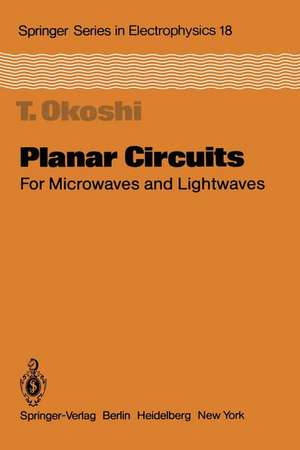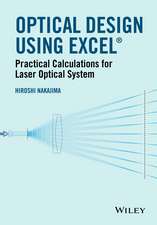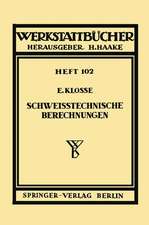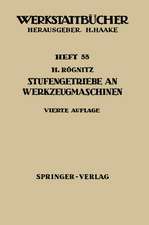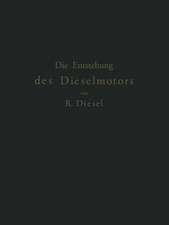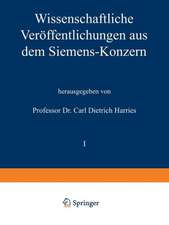Planar Circuits for Microwaves and Lightwaves: Springer Series in Electronics and Photonics, cartea 18
Autor T. Okoshien Limba Engleză Paperback – 17 noi 2011
Din seria Springer Series in Electronics and Photonics
-
 Preț: 389.49 lei
Preț: 389.49 lei - 15%
 Preț: 644.18 lei
Preț: 644.18 lei - 15%
 Preț: 653.79 lei
Preț: 653.79 lei - 15%
 Preț: 648.74 lei
Preț: 648.74 lei -
 Preț: 391.02 lei
Preț: 391.02 lei -
 Preț: 393.13 lei
Preț: 393.13 lei - 15%
 Preț: 645.47 lei
Preț: 645.47 lei -
 Preț: 389.11 lei
Preț: 389.11 lei -
 Preț: 380.45 lei
Preț: 380.45 lei -
 Preț: 394.29 lei
Preț: 394.29 lei - 15%
 Preț: 643.16 lei
Preț: 643.16 lei - 18%
 Preț: 730.35 lei
Preț: 730.35 lei - 18%
 Preț: 943.43 lei
Preț: 943.43 lei - 15%
 Preț: 638.11 lei
Preț: 638.11 lei -
 Preț: 390.63 lei
Preț: 390.63 lei - 15%
 Preț: 641.03 lei
Preț: 641.03 lei - 15%
 Preț: 637.46 lei
Preț: 637.46 lei -
 Preț: 396.24 lei
Preț: 396.24 lei -
 Preț: 395.09 lei
Preț: 395.09 lei -
 Preț: 381.81 lei
Preț: 381.81 lei -
 Preț: 395.47 lei
Preț: 395.47 lei - 15%
 Preț: 646.30 lei
Preț: 646.30 lei - 15%
 Preț: 633.35 lei
Preț: 633.35 lei -
 Preț: 383.93 lei
Preț: 383.93 lei - 15%
 Preț: 641.71 lei
Preț: 641.71 lei -
 Preț: 391.99 lei
Preț: 391.99 lei -
 Preț: 395.09 lei
Preț: 395.09 lei -
 Preț: 390.46 lei
Preț: 390.46 lei - 15%
 Preț: 641.53 lei
Preț: 641.53 lei - 15%
 Preț: 642.18 lei
Preț: 642.18 lei - 15%
 Preț: 642.18 lei
Preț: 642.18 lei - 18%
 Preț: 954.62 lei
Preț: 954.62 lei
Preț: 384.09 lei
Nou
Puncte Express: 576
Preț estimativ în valută:
73.50€ • 76.30$ • 61.29£
73.50€ • 76.30$ • 61.29£
Carte tipărită la comandă
Livrare economică 25 martie-08 aprilie
Preluare comenzi: 021 569.72.76
Specificații
ISBN-13: 9783642700859
ISBN-10: 3642700853
Pagini: 224
Ilustrații: XVI, 202 p.
Dimensiuni: 155 x 235 x 12 mm
Greutate: 0.32 kg
Ediția:Softcover reprint of the original 1st ed. 1985
Editura: Springer Berlin, Heidelberg
Colecția Springer
Seria Springer Series in Electronics and Photonics
Locul publicării:Berlin, Heidelberg, Germany
ISBN-10: 3642700853
Pagini: 224
Ilustrații: XVI, 202 p.
Dimensiuni: 155 x 235 x 12 mm
Greutate: 0.32 kg
Ediția:Softcover reprint of the original 1st ed. 1985
Editura: Springer Berlin, Heidelberg
Colecția Springer
Seria Springer Series in Electronics and Photonics
Locul publicării:Berlin, Heidelberg, Germany
Public țintă
ResearchCuprins
1. Introduction.- 1.1 Seven Ranks in Electrical and Optical Circuitry.- 1.2 Classification and Technical Significance of Planar Circuits.- 1.3 History of Planar Circuit Research.- 1.4 History of Optical Planar Circuit Research.- 1.5 Purpose and Organization of This Book.- 2. Analysis of Planar Circuits Having Simple Shapes.- 2.1 Background.- 2.2 Basic Equations.- 2.3 Derivation of Circuit Characteristics.- 2.4 Examples of Analysis Based on Green’s Function.- 2.5 Determination of Equivalent Circuit Parameters Based on Energy Consideration.- 2.6 Equivalent Circuit of a Multiport Planar Circuit.- 2.7 Validity of the Open-Boundary Assumption.- 2.8 Examples of Planar Circuits Having Simple Shapes.- 2.9 Summary.- 3. Analysis of Planar Circuits Having Arbitrary Shapes.- 3.1 Background.- 3.2 Basic Formulation of the Contour-Integral Method.- 3.3 Circuit Parameters of an Equivalents N Port.- 3.4 Transfer Parameters of a Two-Port Circuit.- 3.5 Numerical Computation Procedure.- 3.6 Examples of Computer Analysis by the Contour-Integral Method.- 3.7 Analyses Based on Eigenfunction Expansion.- 3.8 Summary.- 4. Short-Boundary Planar Circuits.- 4.1 Background.- 4.2 Principle of Analysis.- 4.3 Short-Boundary Planar Circuit Having Two Coaxial Coupling Ports.- 4.4 Short-Boundary Planar Circuit Having Two Waveguide Coupling Ports.- 4.5 Examples of Numerical Analysis.- 4.6 Higher-Order Mode Consideration at Reference Planes.- 4.7 Summary.- 5. Segmentation Method.- 5.1 Background.- 5.2 Theory of Segmentation Method Using S Matrices.- 5.3 Theory of Segmentation Method Using Z Matrices.- 5.4 Summary.- 6. Trial-and-Error Synthesis of Optimum Planar Circuit Pattern.- 6.1 Background.- 6.2 Method of Synthesis.- 6.3 Comparison with Experiment.- 6.4 Computer Time.- 6.5 Summary.- 7. FullyComputer-Oriented Synthesis of Optimum Planar Circuit Pattern.- 7.1 Background.- 7.2 Method of Synthesis.- 7.3 Parameters and Computational Techniques in an Actual Example of Synthesis.- 7.4 Results of Synthesis.- 7.5 Experimental Verification.- 7.6 Further Improvement of Frequency Characteristics by Addition of External Circuits.- 7.7 Evaluation of the Synthesized Circuit Patterns.- 7.8 Summary.- 8. Planar Circuits with Anisotropic Spacing Media.- 8.1 Background.- 8.2 Theories of Analysis.- 8.3 Formulations for Numerical Computation and Examples of Calculation.- 8.4 Comparison of the Eigenfunction-Expansion and Contour-Integral Methods.- 8.5 Optimum Design of Ferrite Planar Circuits.- 8.6 Summary.- 9. Optical Planar Circuits.- 9.1 Background.- 9.2 Wave-Optics Approach to Optical Planar Circuits.- 9.3 Geometrical Optics Approach to Optical Planar Circuits.- 9.4 Optical Planar Circuits Having Uniform Slab Structure.- 9.5 Optical Planar Circuits Having Periodic Structures.- 9.6 Planar Lenses.- 9.7 Summary.- 10. Optical Planar Circuits Having Stripelike Waveguiding Structures.- 10.1 Background.- 10.2 Model to be Considered.- 10.3 Geometrical Optics Approach.- 10.4 Wave-Optics Approaches.- 10.5 Beam-Propagation Method.- 10.6 Summary.- A2.1 Derivation of (2.5).- A2.2 Some Characteristics of Eigenvalues and Eigenfunctions.- A3.1 Weber’s Solution Using Cylindrical Waves.- A3.2 Derivation of (3.1).- A3.3 Choice of the Green’s Function Used in Contour-Integral Analysis.- A4.1 Proof of (4.1) for a Multiply Connected Circuit Pattern.- A8.1 Derivation of (8.5, 8).- A8.2 Derivation of (8.18, 19).- A9.1 Derivation of (9.27).- A9.2 Derivation of (9.32, 33).- References.
